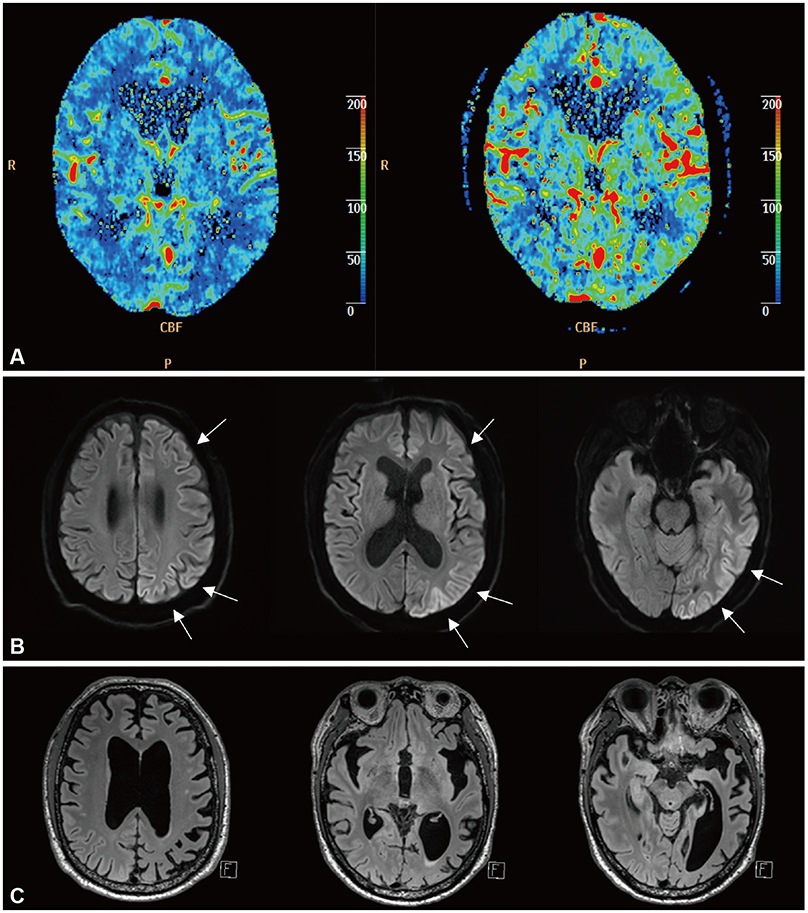J Clin Neurol.
2019 Jul;15(3):421-423. 10.3988/jcn.2019.15.3.421.
Delayed Ipsilateral Regional Cortical Injury after Carotid Endarterectomy
- Affiliations
-
- 1Department of Neurology, Korea University Anam Hospital, Korea University College of Medicine, Seoul, Korea. song4yu@gmail.com
- KMID: 2451135
- DOI: http://doi.org/10.3988/jcn.2019.15.3.421
Abstract
- No abstract available.
MeSH Terms
Figure
Reference
-
1. Karapanayiotides T, Meuli R, Devuyst G, Piechowski-Jozwiak B, Dewarrat A, Ruchat P, et al. Postcarotid endarterectomy hyperperfusion or reperfusion syndrome. Stroke. 2005; 36:21–26.
Article2. Arbelaez A, Castillo M, Mukherji SK. Diffusion-weighted MR imaging of global cerebral anoxia. AJNR Am J Neuroradiol. 1999; 20:999–1007.3. Siskas N, Lefkopoulos A, Ioannidis I, Charitandi A, Dimitriadis AS. Cortical laminar necrosis in brain infarcts: serial MRI. Neuroradiology. 2003; 45:283–288.
Article4. Iihara K, Okawa M, Hishikawa T, Yamada N, Fukushima K, Iida H, et al. Slowly progressive neuronal death associated with postischemic hyperperfusion in cortical laminar necrosis after high-flow bypass for a carotid intracavernous aneurysm. J Neurosurg. 2010; 112:1254–1259.
Article5. Heyer EJ, Sharma R, Rampersad A, Winfree CJ, Mack WJ, Solomon RA, et al. A controlled prospective study of neuropsychological dysfunction following carotid endarterectomy. Arch Neurol. 2002; 59:217–222.
Article6. Chida K, Ogasawara K, Suga Y, Saito H, Kobayashi M, Yoshida K, et al. Postoperative cortical neural loss associated with cerebral hyperperfusion and cognitive impairment after carotid endarterectomy: 123I-iomazenil SPECT study. Stroke. 2009; 40:448–453.
Article7. Traystman RJ, Kirsch JR, Koehler RC. Oxygen radical mechanisms of brain injury following ischemia and reperfusion. J Appl Physiol (1985). 1991; 71:1185–1195.
Article8. Ogasawara K, Yamadate K, Kobayashi M, Endo H, Fukuda T, Yoshida K, et al. Effects of the free radical scavenger, edaravone, on the development of postoperative cognitive impairment in patients undergoing carotid endarterectomy. Surg Neurol. 2005; 64:309–313.
Article
- Full Text Links
- Actions
-
Cited
- CITED
-
- Close
- Share
- Similar articles
-
- Improved Cerevral Blood Flow and Cerebrovascular Reserve after Carotid Endarterectomy in Patients with Carotid Stenosis and Contralateral Carotid Occlusion: Acetazolamide Stress Brain SPECT Study
- Hyperacute hyperperfusion intracerebral hemorrhage complicating carotid endarterectomy: A case report
- Is Carotid Stenting a Reasonable Alternative to Carotid Endarterectomy?
- Microsurgical Endarterectomy for Symptomatic Carotid Artery Stenosis
- The Efficacy of Electroencephalography and Somatosensory Evoked Potential Monitoring for Detecting Cerebral Ischemia during Carotid Endarterectomy under Regional Anesthesia


